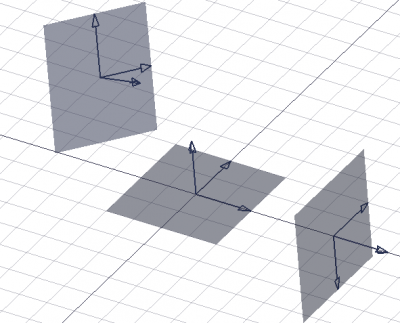Borrador PlanoTrabajoProxy
|
|
| Ubicación en el Menú |
|---|
| Borrador → Utilidades → Crear proxy del plano trabajo |
| Entornos de trabajo |
| Borrador, Arquitectura |
| Atajo de teclado por defecto |
| Ninguno |
| Introducido en versión |
| - |
| Ver también |
| Borrador SeleccionarPlano |
Descripción
Este comando colocará un objeto Proxy de Plano alineado con el actual Plano trabajo.
Este objeto proxy puede usarse como una cara para cambiar rápidamente el plano de trabajo usando la herramienta Borrador SeleccionarPlano. La posición de la cámara y la visibilidad de los objetos en la vista 3D pueden guardarse en el objeto proxy, y restaurarse en cualquier momento cuando se utilice la herramienta Borrador SeleccionarPlano.
Tres proxies de planos de trabajo que muestran diferentes orientaciones y rellenos
Utilización
- Asegúrate de que el Plano trabajo está configurado como quieres.
- A continuación, vaya al menú Borrador → Utilidades →
Crear proxy de plano trabajo.
Notas
- El plano de trabajo almacenado en el objeto Proxy puede restaurarse haciendo doble clic en el objeto en la vista de árbol, o seleccionando el objeto Proxy y utilizando el
Borrador SeleccionarPlano..
- La posición de la cámara se almacena en el objeto Proxy en el momento de su creación. Esta posición puede actualizarse en cualquier momento: haz zoom, panorámica y rotación de la vista como desees, luego haz clic con el botón derecho en el objeto Proxy en la vista de árbol y selecciona
. Escribir posición de la cámara.
- El estado de visibilidad de todos los objetos también se almacena en el objeto Proxy en el momento de su creación. Este estado puede actualizarse en cualquier momento: establezca la propiedad VistaVisibility de los objetos a
trueofalsesegún desee, luego haga clic con el botón derecho en el objeto Proxy en la vista de árbol, y seleccioneEscribir estado de los objetos.
- Los proxies de plano pueden moverse y girarse como cualquier otro objeto para que definan el plano de trabajo deseado. Su apariencia visual también se puede cambiar en el Editor de propiedades.
Propiedades
Data
- DatosPlacement: specifies the position of the proxy object and the corresponding working plane.
- DatosPosition: specifies the coordinates of the proxy object.
- DatosAngle: specifies the rotation angle of the proxy object.
- DatosAxis: specifies the axis to use for the rotation angle.
View
- VistaDisplay Size: specifies both length and width of the proxy object. If the object is created in the tree view but no element is visible in the 3D view, increase this value until it is visible.
- VistaArrow Size: specifies the size of the arrows indicating the three axes of the plane proxy.
- VistaRestore View: if it is
truethe camera position will be restored to the saved position when using the proxy withDraft SelectPlane or by double-clicking on it.
- VistaRestore State: if it is
truethe visibility state of all objects will be restored to the saved state when using the proxy withDraft SelectPlane or by double-clicking on it.
Guión
Ver también: Borrador API y FreeCAD Fundamentos de Guión.
Los objetos proxy del plano de trabajo se pueden utilizar en macros y desde la consola de Python utilizando la siguiente función:
WPProxy = makeWorkingPlaneProxy(placement)
- Creates a
WPProxyobject from the givenplacementwhich is aFreeCAD.Placement.- A placement is defined by a base point, given by its
FreeCAD.Vector, and aFreeCAD.Rotation.
- A placement is defined by a base point, given by its
The size of the Plane Proxy can be changed by overwriting its ViewObject.DisplaySize and ViewObject.ArrowSize attributes, with units in millimeters.
The Plane Proxy has a "Face" object as its Shape attribute. This face can be used to set the current working plane by calling its alignToFace() method.
Ejemplo:
import FreeCAD, FreeCADGui, Draft
currentWP = FreeCAD.DraftWorkingPlane
place = currentWP.getPlacement()
WPProxy = Draft.makeWorkingPlaneProxy(place)
WPProxy.ViewObject.DisplaySize = 3000
WPProxy.ViewObject.ArrowSize = 200
YAxis = FreeCAD.Vector(0, 1, 0)
point2 = FreeCAD.Vector(3000, 0, 0)
place2 = FreeCAD.Placement(point2, FreeCAD.Rotation(YAxis, 90))
WPProxy2 = Draft.makeWorkingPlaneProxy(place2)
WPProxy2.ViewObject.DisplaySize = 3000
WPProxy2.ViewObject.ArrowSize = 200
Axis = FreeCAD.Vector(1, 1, 1)
point3 = FreeCAD.Vector(-3000, 3000, 0)
place3 = FreeCAD.Placement(point3, FreeCAD.Rotation(Axis, 90))
WPProxy3 = Draft.makeWorkingPlaneProxy(place3)
WPProxy3.ViewObject.DisplaySize = 3000
WPProxy3.ViewObject.ArrowSize = 200
FreeCAD.ActiveDocument.recompute()
currentWP.alignToFace(WPProxy3.Shape)
FreeCADGui.Snapper.setGrid()
- Drafting: Line, Polyline, Fillet, Arc, Arc by 3 points, Circle, Ellipse, Rectangle, Polygon, B-spline, Cubic Bézier curve, Bézier curve, Point, Facebinder, ShapeString, Hatch
- Annotation: Text, Dimension, Label, Annotation styles, Annotation scale
- Modification: Move, Rotate, Scale, Mirror, Offset, Trimex, Stretch, Clone, Array, Polar array, Circular array, Path array, Path link array, Point array, Point link array, Edit, Subelement highlight, Join, Split, Upgrade, Downgrade, Wire to B-spline, Draft to sketch, Set slope, Flip dimension, Shape 2D view
- Draft Tray: Select plane, Set style, Toggle construction mode, AutoGroup
- Snapping: Snap lock, Snap endpoint, Snap midpoint, Snap center, Snap angle, Snap intersection, Snap perpendicular, Snap extension, Snap parallel, Snap special, Snap near, Snap ortho, Snap grid, Snap working plane, Snap dimensions, Toggle grid
- Miscellaneous: Apply current style, Layer, Manage layers, Add a new named group, Move to group, Select group, Add to construction group, Toggle normal/wireframe display, Create working plane proxy, Heal, Show snap toolbar
- Additional: Constraining, Pattern, Preferences, Import Export Preferences, DXF/DWG, SVG, OCA, DAT
- Context menu:
- Layer container: Merge layer duplicates, Add new layer
- Layer: Activate this layer, Select layer contents
- Text: Open hyperlinks
- Wire: Flatten
- Working plane proxy: Write camera position, Write objects state
- Getting started
- Installation: Download, Windows, Linux, Mac, Additional components, Docker, AppImage, Ubuntu Snap
- Basics: About FreeCAD, Interface, Mouse navigation, Selection methods, Object name, Preferences, Workbenches, Document structure, Properties, Help FreeCAD, Donate
- Help: Tutorials, Video tutorials
- Workbenches: Std Base, Arch, Assembly, CAM, Draft, FEM, Inspection, Mesh, OpenSCAD, Part, PartDesign, Points, Reverse Engineering, Robot, Sketcher, Spreadsheet, Surface, TechDraw, Test Framework
- Hubs: User hub, Power users hub, Developer hub
